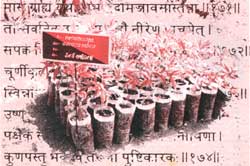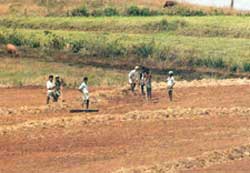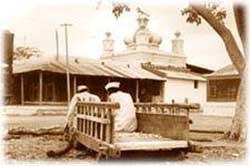
Pickled power
Hill women, long deprived of any economic rights, have found their independent, confident voice in activities spurred by a welfare group

Hill women, long deprived of any economic rights, have found their independent, confident voice in activities spurred by a welfare group

Renovating traditiona_1 village reservoirs, farmers in Tamil Nadu are pursuing a green dream
The milestone read Nimalapedu 0. We had travelled through the forest regions of Vishakapatnam, Andhra Pradesh, to this tribal village, which we knew had stoutly resisted and tamed the might of the
Some innovations change lives. A favourite of mine is the village milk collection system, a cooperative model. There s a dairy in the village, people bring in milk, the dairy in
The government is being severely criticised for the wheat it is now planning to import. Rightly so. India s season for wheat ended a few months ago. When the crop was being harvested the
Finance Minister P. Chidambaram's initiative is a major step in recognising the country's debt to farm families but much more needs to be done. Finance Minister P. Chidambaram's budget 2008-09 has aroused widespread interest in methods of saving our small and marginal farming families from indebtedness and acute economic distress, which lead to occasional suicides. The steps proposed in the budget will give relief to nearly four crore farmers, at an estimated outlay of Rs.60,000 crore. As stressed by Mr. Chidambaram, this is a major step in recognising the indebtedness of the country to farm families who, th rough their toil in sun and rain, are safeguarding national food security and sovereignty. The question arises whether this step will mark the end of farmers' dependence on moneylenders and traders for their credit needs. Some of the following issues need consideration: First, the definition of small and marginal farmers has to be different for irrigated and dry farming areas. The present definition classifies marginal farmers as those owning up to 1 hectare and small farmers as those owning 1-2 hectares. Farmers cultivating crops in rainfed, arid, and semi-arid areas may own 4-5 hectares but their income is uncertain and their agricultural destiny is bound closely to the behaviour of the monsoon. A large number of farming families affected by the agrarian crisis in Vidharbha fall under this category. They will not be eligible for debt waiver and debt relief under the present scheme. A second problem relates to the source from which loans have been taken. The programme announced in the budget covers farmers who have taken loans from scheduled commercial banks, regional rural banks, and cooperative credit institutions. It does not cover farmers indebted to moneylenders and traders. According to the National Sample Survey Organisation (NSSO), 48.6 per cent of the farm households surveyed were indebted; of these 61 per cent had operational holdings below 1 hectare. Of the total outstanding debt, 41.6 per cent was taken for purposes other than farm-related activities, such as healthcare and domestic needs; 57.7 per cent of the outstanding amount was sourced from institutional channels and 42.3 per cent from moneylenders, traders, relatives, and friends. It has been estimated that in 2003, non-institutional debt accounted for Rs.48,000 crore; and out of this, Rs.18,000 crore was at an interest of 30 per cent per annum or more (NSSO 59th Round cited by the Economic Survey 2007-08). The Expert Group on Agriculture Indebtedness chaired by Professor R. Radhakrishna has recommended, in its report of July 2007, the inclusion of the financially excluded, particularly the small borrower households, and the adoption of risk-mitigating measures for agriculture. The concept of financial inclusion is in its early stages of operationalisation. Loan waiver is the price we have to pay for the neglect of rural India during the past several decades, as reflected in a gradual decline in investment in key sectors like irrigation, post-harvest technology (even today, farmers dry the harvested paddy on roads), market, and communication. The four crore farmers who are to be relieved of their debt burden before the end of June 2008 will become eligible once again for institutional credit for their cultivation expenses during kharif 2008. The challenge now is to prevent them from getting into the debt trap again. For this purpose, both Central and State governments should set up immediately an Indebted Farmers' Support Consortium at the district level. This should comprise farm scientists, panchayati raj leaders, input supply agencies, representatives of relevant government departments and financial institutions, rural and women's universities and home science colleges, private sector and media representatives, and others relevant to assisting the farmers relieved of their past debt in improving the productivity and profitability of their farms in an environmentally sustainable manner. This is essential for enabling them to have a higher marketable surplus and thereby more cash income. The smaller the farm, the greater is the need for marketable surplus to avoid indebtedness. Such an Indebted Farmers' Support Consortium should get the four crore farmers the benefits of all the government schemes such as the Rashtriya Krishi Vikas Yojana, the National Food Security Mission, the Accelerated Irrigation Benefit Programme, the National Horticulture Mission, Rural Godown and Warehousing Schemes, and the National Rural Health Mission. If this is done, every farm family released from the debt trap should be able to produce at least an additional half tonne per hectare of food grains or other farm produce. This should help increase food production by about 20 million tonnes during 2008-10. At a time when global and national food stocks are dwindling and prices are rising, this will be an extremely timely gain for our national food and nutrition security system and for the control of inflation. We should ensure that the outcome of debt waiver is enhanced farmers' income and production. The prevailing gap between potential and actual yields in the crops of rainfed areas such as jowar, bajra, millets, pulses, and oilseeds is over 200 per cent even with the technologies on the shelf. The restarting of the agricultural career of four crore resource-poor farmers through loan waiver could mark a new dawn in both agrarian prosperity and national food sovereignty

<p><span style="font-size:14px;"><strong>Renewable Energy</strong></span></p> <p><img alt="" src="http://www.indiaenvironmentportal.org.in/files/country/nepal/biogas_hl.jpg" style="border-width: 2px; border-style: solid;" /></p> <p>The major energy resource base in Nepal consists of biomass, hydroelectricity, petroleum products, natural gas, and coal reserves. Among the entire energy resource base, it is evident that biomass is the dominant resource base of the country with respect to its utilization. Biomass provided 86% of the total energy consumption, petroleum 9%, which is mainly consumed by urban areas, electricity only 2% and renewable 1% of the total energy consumption.</p>

It was from the port towns of this region that Arab dhows laden with merchandise set sail for distant towns in the days of yore. Today, these towns lie deserted -- an eloquent comment on the ecological devastation that has visited the Indus del

The search for easily applicable environment-friendly plant protection technologies could very well find its answer in the pages of history

Just as <font colour=red>Brazil</font> and <font colour=red>Nigeria </font>lie Geographically parallel to each other along the Atlantic, the fates of their seem sealed in a similar fashion. The <font colour=red>Yanornami </font>of Brazil and the

Incredible though it may seem, it is being claimed that cancer and multiple sclerosis, the two deadly diseases that have often eluded cure, can be successfully treated with Rasayan Shastra or metal therapy. But to the practitioner of modem medicihe,

A new development programme in Palamau in Bihar, a rich land with poor people, can set the pace for a reversal of fortune

After a 10 year crusade, Sri Lankan environmentalists finally got what they wanted: mandatory environmental impact assessments for development projects. But the whole thing is riddled with glitches...

Madras is a chronically water-starved metropolis, and it provides invaluable insights into how integrated water management could be the last life-saver
With the help of the Indian Institute of Technology in Bombay, a premier scientific research organisation, the Patriotic and People-Oriented Science and Technology Foundation (PPST), a science-based

The Union environment minister says that a comprehensive bill to protect India"s biodiversity is on the anvil. But whether it can be a timely, effective measure that give farmers and tribals right over their biological knowledge, remains to be seen.

A programme in Zimbabwe strives to conserve wildlife and maintain development on the premise that villagers will utilise natural resources in a sustainable manner if they can perceive the benefits to them

Small is not always beautiful: Small-scale industries in India account for only 35 per cent of the country"s industrial production, but their share of pollution is a whopping 65 per cent.

The Adarsh Gaon Yojana was set up to empower some 300 villages in Maharashtra. After eight long years, it is yet to show results. The people involved hold the state"s apathy and the red tapism responsible for the failure of this rural dream of self-suffic

The fragile ecology of the Garhwal Himalaya witnessed another season of cloudbursts, landslides and flash floods made worse by the 1991 earthquake in the Bhagirathi valley. Down To Earth compiled a firsthand report of life in the unstable Himalayan ran